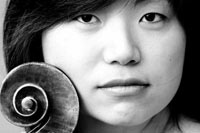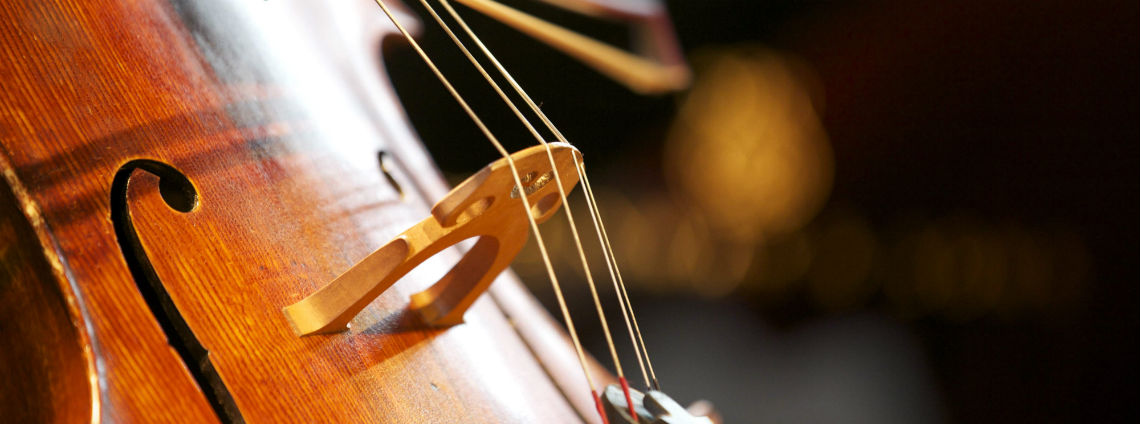Christ Church Cathedral | Map
Beiliang Zhu, violoncello
Let imagination run wild in a selection of the classic Bach Cello Suites. Each movement is a different scene; each dance is a different spirit. Bach’s genius is not only his compositions but also the portals through which the performer and the listeners enter magical realms.
Baroque cellist Beiliang Zhu is a past winner of the Leipzig International Bach Competition. She views playing the richly chorded suites with six movements each—a prelude, allemande, courante, sarabande, gigue, and other dances—as an “extraordinary journey”. Beiliang is the new principal cellist of the Pacific Baroque Orchestra.
“Zhu added telling nuances to the repeating bass…elegant and sensual, stylishly wild.” – The New Yorker
“The orchestra played vibrantly, with particularly exciting work from the cellist and violist da gamba Beiliang Zhu…” – The New York Times
Click here for information about parking around / transiting to Christ Church Cathedral
Programme
Johann Sebastian Bach: suites for solo cello
SUITE NO.1 IN G MAJOR (BWV 1007)
Prelude
Allemande
Courante
Sarabande
Minuet I & II
Gigue
SUITE NO.4 IN E-FLAT MAJOR (BWV 1010)
Prelude
Allemande
Courante
Sarabande
Bourrée I & II
Gigue
INTERVAL
SUITE NO.2 IN D MINOR (BWV 1008)
Prelude
Allemande
Courante
Sarabande
Minuet I & II
Gigue
SUITE NO.3 IN C MAJOR (BWV 1009)
Prelude
Allemande
Courante
Sarabande
Bourrée I & II
Gigue
Programme Notes
In 1720, Johann Sebastian Bach made a magnificently clear copy of his six solos for the violin, which he subtitled “Libro primo:” book one. Book two is presumably the parallel set of six suites for violoncello, but there is no authoritative word from Bach on the subject. His autograph manuscript is lost, and none of these works were published in his lifetime. As a result, the provenance of the incomparable suites is a matter of speculation. Tradition holds that they were likely written during Bach’s employment at the court of Prince Leopold of Anhalt-Kothen, between 1717 and 1723. During that time, due to the Reformed faith of his employer, he was free from the duty of routine production of music for the liturgy, and he composed a great deal of instrumental and other secular music.
The most succinct articulation of the singular qualities of Johann Sebastian Bach’s works for unaccompanied string instruments comes from the first biography of the composer, by Johann Nikolaus Forkel, published in 1802. “How far Bach’s meditation and penetration in the treatment of melody and harmony was carried, how much he was inclined to exhaust all the possibilities of both, appears furthermore from his attempt to contrive a single melody in such a manner that no second singable part could be set against it … To this attempt we are indebted for six solos for the violin and six others for the violoncello, which are without any accompaniment and which absolutely admit of no second singable part set to them. By particular turns in the melody, he has so combined in a single part all the notes required to make the modulation complete that a second part is neither necessary nor possible.”
Despite Forkel’s emphasis on the qualities of single lines in Bach’s string writing, there are in fact many full-voiced chords in the solo works. Executing many chords in a row on a single stringed instrument requires great prowess and coordination, and because of this athletic quality, performers tend to see the most thickly-written of Bach’s solos as the most advanced in style. For this reason, speculative chronologies have often positioned the cello suites as early works, perhaps a kind of compositional warm-up to the violin solos. However, examining the antecedents to both works, it is clear that the cello suites are at least equally progressive, and perhaps even more so. There was a well-established tradition in Germany of playing contrapuntal music on the violin without bass, dating back to the middle of the seventeenth century. Several composers Bach was acquainted with, including Johann Paul von Westhoff and Johann Georg Pisendel, wrote ambitious polyphonic works for solo violin. While Bach’s accomplishment in this arena was of a different magnitude from that of his contemporaries, his work in explicit polyphony for the violin had clear precedents.
The implicit polyphony which Forkel describes, however, has no real precedent at all. It is in the cello suites that Bach pushed this idea to its limits, for example in the magical sarabande of the fifth suite, in which no distinction can be made between melodic and harmonic writing, and not a single double stop is necessary to flesh out the rich harmony. While solo string writing without multiple stops may simplify matters for the performer, it greatly complicates them for the composer, at least for one as uncompromising as Bach. If Forkel’s characterization of Bach’s designs is correct, than it is possible to view the cello suites as the culmination of Bach’s pursuit of containing the maximum of musical information in a single, beautifully flowing line.
Formally, the cello suites are typical of French dance suites. Each opens with a prelude. The preludes to the first four suites are improvisatory in nature, spinning out a single motive and exploring its harmonic possibilities. The fifth suite’s prelude is in the form of a French overture, with a slow introduction followed by a fast movement with an imitative, quasi-fugal texture. The sixth suite’s prelude is closest in style to an Italianate sinfonia, which might precede an opera or a festive cantata. Each prelude is followed by an allemande, which in a sense means that each suite has two preludes. By Bach’s time, the allemande was an antiquated dance; no eighteenth-century choreographies for it are known, and it was often described by writers in Bach’s time as an instrumental form, preludial in function and meditative in character. Bach himself used it in lieu of preludes proper at the beginnings of his first and second violin partitas. Nevertheless, there is a common rhythmic profile among all of Bach’s allemandes: they are in quadruple time, with a short upbeat and prominent dotted rhythms throughout. The Renaissance dance from which it descends was a processional characterized by a long-short-short rhythmic pattern. Bach’s more immediate models were the keyboard allemandes of Froberger.
The courantes, and all the other movements which follow in each suite, are classic French courtly dances typical of Versailles under Louis XIV, and therefore widely imitated throughout Europe. A quite athletic dance (the name comes from the verb courir, to run), German courantes of Bach’s time were danced to music of great poise, described by Bach’s cousin Johann Gottfried Walther in his musical dictionary as “the most serious one can find.” After the courantes come sarabandes. The sarabande began as a fast dance in Central America; on arrival in Europe in the 16th century, it was very popular, especially in Spain, and remained so despite a ban in 1583. By the late 18th century, the musical features had ossified and been slowed down into a highly stylized French dance. It is in triple time.
Between each sarabande and the concluding gigues, Bach inserted pairs of less serious dances: minuets, bourrées, or gavottes. The choice of “optional” dance for each suite is crucial to its character, as it is the only point of variation in the layout of these suites. The first two suites have minuets, the second two bourrées, and the latter two gavottes; this formal pairing of the suites is typical of Bach’s careful planning, and gives symmetry to the cycle. Each suite concludes with a gigue, the French cousin of the English jig, which is festive and suitable for the end of an evening of dancing.
The fifth and six suites are also set apart from the rest by technical considerations. The fifth is written in a scordatura or mistuning, with the top string of the cello tuned down a whole step. This alters the resonance and the harmonic capabilities of the instrument. It also links Bach to earlier music for solo cello, as the same tuning was employed by Domenico Gabrielli in his Ricercars some sixty years prior. The sixth suite calls for a cello with five strings rather than the usual four, the fifth extending the top of the cello’s range. Both suites can be performed on a standard four-string cello in the usual tuning, and often are.
In 1720, the year that Bach marked his violin solos as “Libro primo” of an unspecified larger body of work, he left Kothen for a period of two months with Prince Leopold. When he returned, he learned that his wife, Maria Barbara, had died suddenly in his absence. Bach had already suffered considerable familial misfortune by this time, including the loss of both parents at a young age (though the worst was still to come, in the dissolute early death of his talented son, Johann Gottfried Bernhard). By all accounts Bach was devastated. However, at the end of the next year, he married the singer Anna Magdalena Wilcke. This second marriage produced tremendous musical fruit, as Anna Magdalena sang many of her husband’s works and also worked closely with him as a copyist. The copy of the cello suites closest to the lost original is in her hand. Whenever they were written, our only remaining link to their creation must date from 1722 or later, by which time Bach was beginning a new life, not only with his new wife and the many children they raised together, but also looking towards Leipzig, where he would soon assume the Thomaskantorate, the position he held for the rest of his life, and in which he created a body of sacred music unlike anything else in musical history.
– Jude Ziliak

Beiliang Zhu, violoncello
Beiliang Zhu won the 1st prize and the Audience Award at the 2012 International Bach Competition in Leipzig (Violoncello/Baroque Violoncello). She was the first string player to receive this honor for performance on a baroque instrument. She completed her Master of Music from the Juilliard School in Historical Performance with Phoebe Carrai (Baroque cello) and Sarah Cunningham (Viola da Gamba), her Bachelor of Music and a Performer’s Certificate from the Eastman School of Music. Beiliang is currently pursuing a Doctor of Musical Arts in Violoncello, under the guidance of Steven Doane, as well as a Master of Arts in Ethnomusicology at the Eastman School of Music.
Hailed by the New York Times as “particularly exciting”, and by the New Yorker as bringing “telling nuances”, and as being “elegant and sensual, stylishly wild”, Beiliang has given solo recitals at the Bach Festival Leipzig, Boston Early Music Festival, The Vancouver Bach Festival, the Seoul Bach Festival and the Helicon Foundation. She has also performed with internationally acclaimed artists and ensembles, such as William Christie, Masaaki Suzuki, Monica Huggett, Paul O’Dette, the Boston Early Music Festival Orchestra, Juilliard Baroque, the Philadelphia Orchestra and the Trinity Wall Street Orchestra. She won a section cellist position in the Rochester Philharmonic Orchestra while still an undergraduate and continues to hold the principal cellist position of Mercury Houston.


